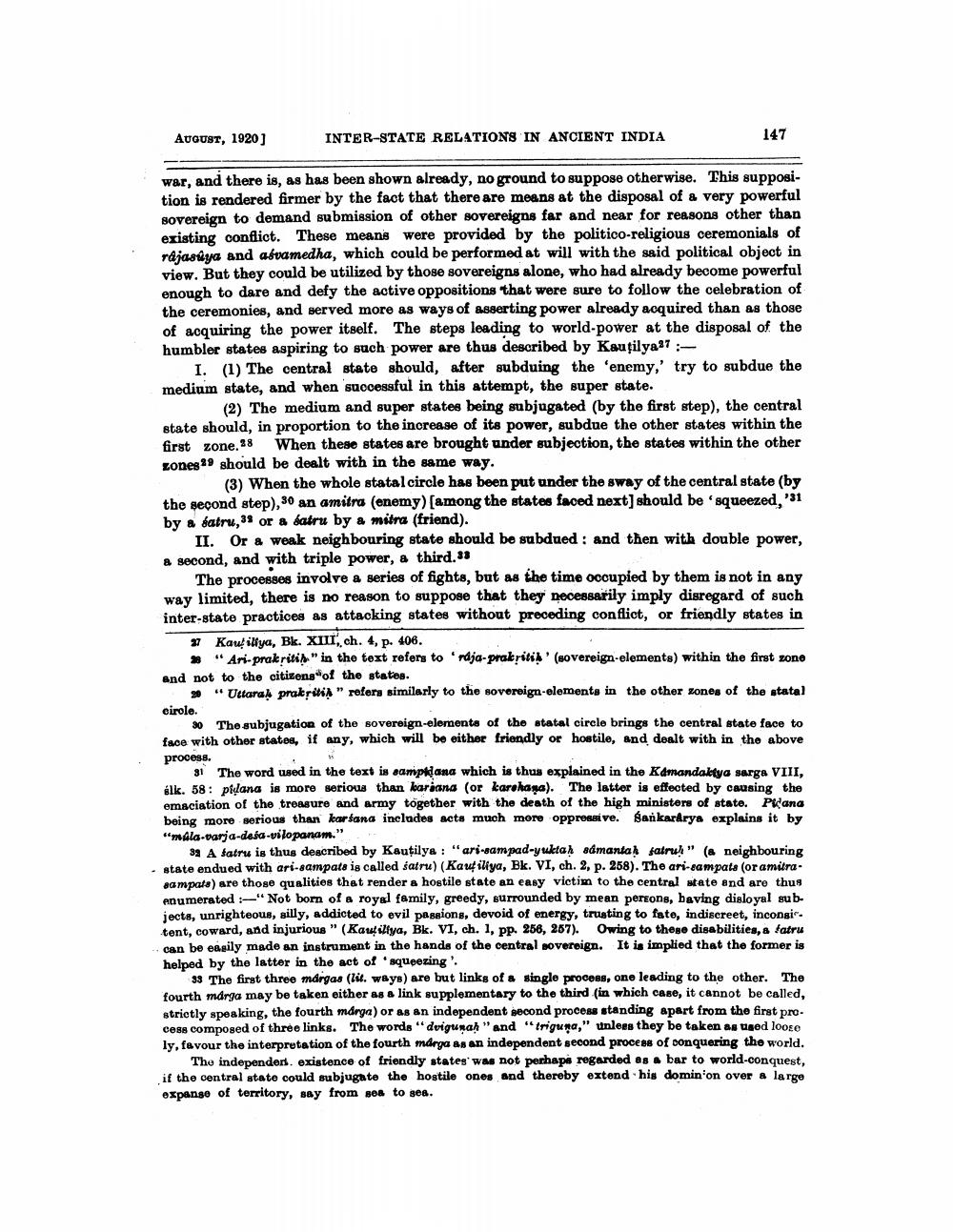________________
August, 1920)
INTER-STATE RELATIONS IN ANCIENT INDIA
147
war, and there is, as has been shown already, no ground to suppose otherwise. This supposition is rendered firmer by the fact that there are means at the disposal of a very powerful sovereign to demand submission of other sovereigns far and near for reasons other than existing conflict. These means were provided by the politico-religious ceremonials of rajasúya and afvamedha, which could be performed at will with the said political object in view. But they could be utilized by those sovereigns alone, who had already become powerful enough to dare and defy the active oppositions that were sure to follow the celebration of the ceremonies, and served more as ways of asserting power already acquired than as those of acquiring the power itself. The steps leading to world-power at the disposal of the humbler states aspiring to such power are thus described by Kautilya 37 :
1. (1) The central state should, after subduing the enemy,' try to subdue the medium state, and when successful in this attempt, the super state.
(2) The medium and super states being subjugated by the first step), the central state should, in proportion to the increase of its power, subdue the other states within the first zone. 28 When these states are brought under subjection, the states within the other zones 29 should be dealt with in the same way.
(3) When the whole statal circle has been put under the sway of the central state (by the second step), 30 an amitra (enemy) (among the states faced next) should be squeezed, '31 by a batru, 3 or a batru by a mitra (friend).
II. Or a weak neighbouring state should be subdued : and then with double power, a second, and with triple power, a third. 33
The processes involve a series of fights, but as the time oooupied by them is not in any way limited, there is no reason to suppose that they necessarily imply disregard of such inter-state practices as attacking states without preceding conflict, or friendly states in
2 Kautilya, Bk. XIII.ch. 4, p. 406.
>> "Ari-prakriti" in the text refers to 'rája-prakriti '(sovereign elements) within the first zone and not to the citizens of the states.
> "Uttara) prakriti" refers similarly to the sovereign-elements in the other ones of the statal cirole.
30 The subjugation of the sovereign-elements of the statal circle brings the central state face to face with other states, if any, which will be either friendly or hostile, and dealt with in the above process.
31 The word used in the text is sampllana which is thus explained in the Kamandaktya sarga VIII, alk. 58: pidana is more serious than harians (or karohana). The latter is effected by causing the emaciation of the treasure and army together with the death of the high ministers of state. Plana being more serious than karsana includes acts much more oppressive. Sankarrys explains it by "mala-varja-desa-vilopanam."
39 A fatru is thus described by Kautilya : "ari-sampad-yukta admantas satrul" ( neighbouring state endued with ari-sampata is called satru) (Kaufiliya, Bk. VI, ch. 2, p. 258). The ari-sampals (or amitra. sampata) are those qualities that render a hostile state an easy victim to the central mate and are thus enumerated :-"Not born of a royal family, greedy, surrounded by mean persone, baving disloyal subjects, unrighteous, silly, addicted to evil passions, devoid of energy, trusting to fato, indiscreet, incongir. tent, coward, and injurious" (Kaufiliya, Bk. VI, ch. 1, pp. 256, 287). Owing to these disabilities, a fatru can be easily made an instrument in the hands of the central sovereign. It is implied that the former is helped by the latter in the act of squeezing!
33 The first three margas (lit. ways) are but links of a single process, one leading to the other. The fourth mdrga may be taken either as a link supplementary to the third (in which case, it cannot be called, strictly speaking, the fourth marga) or as an independent second process standing apart from the first process composed of three links. The words "dvigunah" and "triguma," unlees they be taken as ugod loose ly, favour the interpretation of the fourth mdrga as an independent second process of conquering the world.
The independers. existence of friendly states' was not perhaps regarded as a bar to world.conquest, if the central state could subjugate the hostile ones and thereby extend his domin'on over a large expanse of territory, say from sos to sea.




